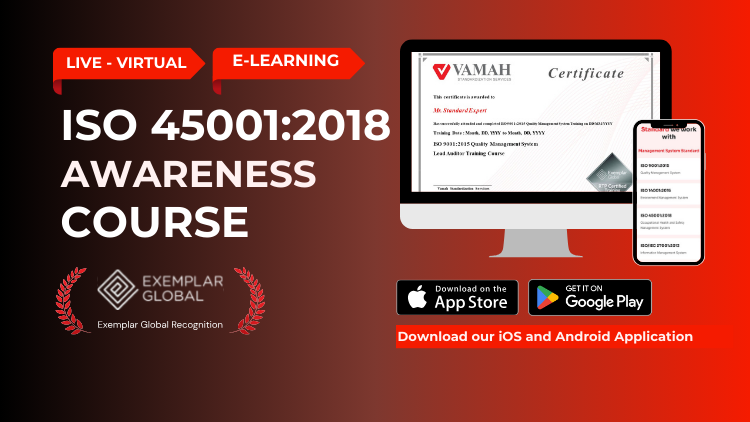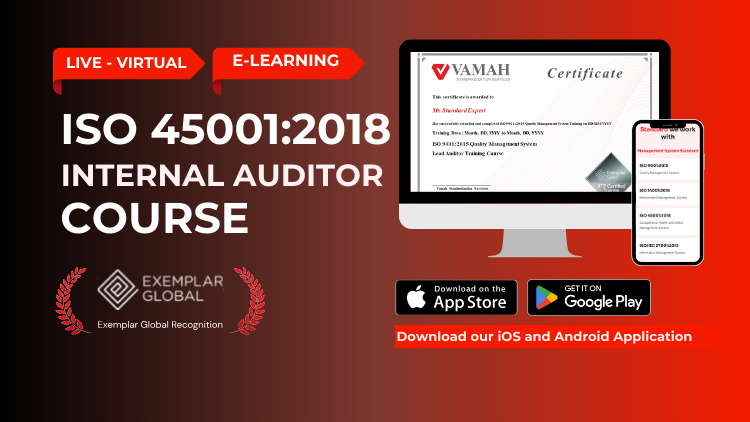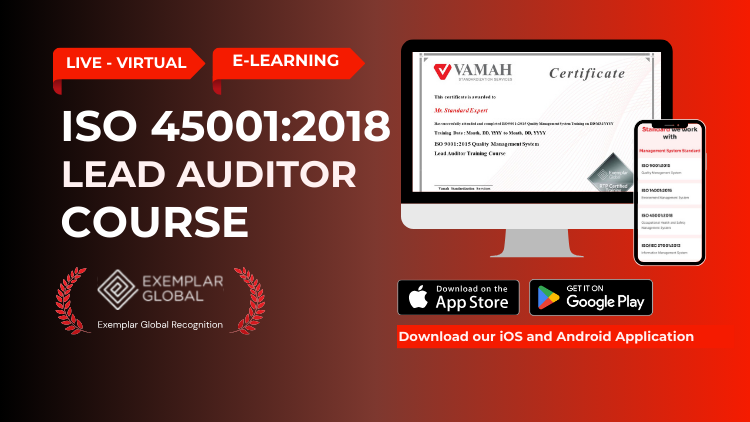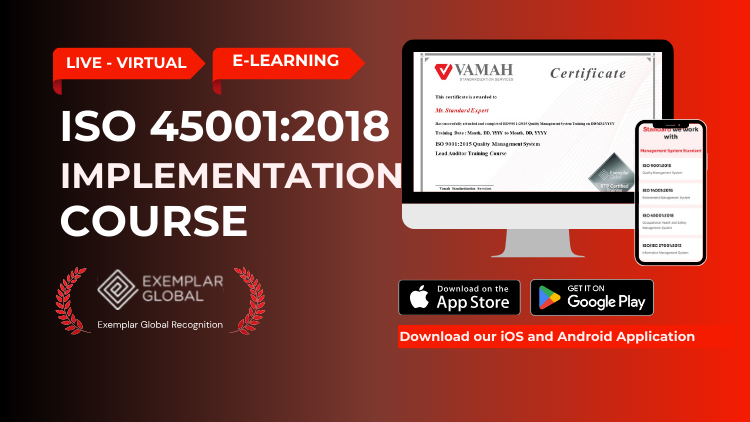ISO 45001:2018
ISO 45001:2018 is an internationally recognized standard for Occupational Health and Safety Management Systems (OH&S). It provides a framework for organizations to improve employee safety, reduce workplace risks, and create better, safer working conditions. ISO 45001 is applicable to any organization, regardless of size, industry, or nature of business, aiming to proactively improve its OH&S performance.
Trainings
Our trainings are developed for ISO 45001:2018 with various level such as Awareness, Internal Auditor, Lead Auditor and Implementation.
ISO 45001:2018 Awareness Training
Our Awareness Training introduces participants to the fundamental concepts of ISO 45001:2018. This course covers the importance of occupational health and safety management, key principles of the ISO 45001 standard, and the benefits of implementing an OH&S management system. It is ideal for employees at all levels who need a basic understanding of ISO 45001.

ISO 45001:2018 Internal Auditor Training
Our Internal Auditor Training is designed for individuals who will be conducting internal audits within their organizations. This course provides in-depth knowledge of the audit process, including planning, executing, reporting, and following up on audits.
Participants will learn how to evaluate the effectiveness of their OH&S management system and identify areas for improvement, ensuring ongoing compliance with ISO 45001:2018 requirements.

ISO 45001:2018 Lead Auditor Training
Our Lead Auditor Training is intended for professionals seeking to become certified lead auditors. This comprehensive course covers advanced auditing techniques, audit planning and execution, and the principles of ISO 19011, the international standard for auditing management systems.
Participants will gain the expertise needed to lead successful audits and drive continuous improvement within their organizations as per ISO 45001:2018 requirements.

ISO 45001:2018 Implementation Training
Our Implementation Workshop offers hands-on guidance for organizations in the process of implementing ISO 45001:2018 Occupational Health and Safety Management System. This workshop covers the development of essential documentation, including OH&S manuals, procedures, and work instructions.
Participants will learn how to integrate ISO 45001 requirements into their existing processes and ensure a smooth transition to a certified OH&S management system.

DIY Templates
- Cost-Effective: Save on consultancy fees.
- Time-Saving: Ready-made documents for quick implementation.
- Comprehensive: Includes all necessary documents.
- Customizable: Easily adapt to your organization’s needs.
- Expertly Crafted: Developed by industry professionals.
- Streamlined Process: Clear instructions reduce the learning curve for team members.
Implement ISO 45001:2018 with DIY Templates
ISO 45001:2018 Consultancy
At VamahSS, we assist organizations in navigating the complexities of ISO standards implementation, certification, and continual improvement. Recognizing that every organization is unique, we provide tailored solutions to fit specific needs, making us your trusted partner in achieving ISO certification. Whether starting your ISO journey or optimizing existing processes, our consultancy services are designed to meet your objectives.We offer remote ISO consultancy services for various management system standards and accreditation standards. Choose between our two consulting options: online workshops or full project support tailored to your requirements. Contact us today to start your path to ISO certification.
Contact Us
Occupational Health & Safety Management System
ISO 45001:2018 is an internationally recognized standard for Occupational Health and Safety Management Systems (OH&S). This guide provides a comprehensive overview of ISO 45001, its importance, implementation process, and business impact.
What is ISO 45001?
Why is ISO 45001 Important?
What is the Current ISO 45001 Standard?
ISO 45001 vs. OHSAS 18001
ISO 45001:2018 is the updated version of OHSAS 18001, the previous occupational health and safety standard. While OHSAS 18001 focused on compliance and risk management, ISO 45001 introduces a more integrated approach, aligning with other management system standards and emphasizing continual improvement and leadership commitment.
What is an Occupational Health and Safety Management System (OH&S)?
Clause 4: Context of the Organization
Clause 5: Leadership and worker participation
Clause 6: Planning
Clause 7: Support
Clause 8: Operation
Clause 9: Performance Evaluation
Clause 10: Improvement
Implementing ISO 45001:2018 not only enhances your occupational health and safety practices but also demonstrates your commitment to the well-being of your employees and regulatory compliance. Partner with Vamah Standardization Services LLP to achieve certification and drive continuous improvement in your OH&S performance. Contact us today to begin your journey towards a safer, healthier workplace.
Step 1 Preparation: Gap Analysis and Documentation
Documentation: Develop the necessary documentation, including the OH&S manual, risk assessments, procedures, and policies. Ensure that these documents address the requirements of ISO 45001 and provide clear guidelines for managing health and safety risks.
Step 2. Management Commitment
Policy Development: Create an OH&S policy that reflects your organization’s commitment to health and safety. This policy should align with ISO 45001 requirements and set clear objectives for continuous improvement.
3. Training and Awareness
Awareness Programs: Implement awareness programs to keep employees informed about health and safety practices, changes in procedures, and the importance of compliance with ISO 45001.
Step 4. Risk Assessment and Management
Implement Controls: Develop and implement control measures to mitigate identified risks. This includes establishing procedures for monitoring, controlling, and reviewing these risks to ensure ongoing effectiveness.
Step 5. Internal Audit
Conduct Audits: Perform the internal audits to identify non-conformities and areas for improvement. Document audit findings and implement corrective actions to address any issues uncovered.
Step 6. Management Review
Step 7. Certification Audit
Step 8. Surveillance and Recertification
By following these steps, your organization can effectively implement ISO 45001:2018, ensuring a robust Occupational Health and Safety Management System that enhances workplace safety and regulatory compliance.
What is OH&S Certification?
Is ISO Certification Mandatory?
How Much Does it Cost to Get ISO 45001 Certification?
Step 1 Preparation
Gap Analysis and Documentation: Begin by conducting a thorough gap analysis to compare your current health and safety practices against ISO 45001:2018 requirements. This assessment identifies areas needing improvement.
Next, develop and document the necessary policies, procedures, and protocols to meet ISO 45001 standards. This includes creating an Occupational Health and Safety (OH&S) manual, risk assessments, and emergency procedures.
Step 2 Training
Educate Employees and Management: Effective implementation of ISO 45001 requires that all employees and management understand the standard’s requirements.
Provide targeted training sessions to educate staff on their roles and responsibilities within the OH&S management system. This training should cover the principles of ISO 45001, risk management, and how to use new procedures and documentation.
Step 3 Internal Audit
Step 4 Management Review
Step 5 Certification Audit:
External Verification: Engage a certification body to conduct an external audit of your OH&S management system. This certification audit verifies that your system meets ISO 45001:2018 standards.
Auditors will review your documentation, observe practices, and assess compliance. Address any non-conformities identified during the audit to achieve certification.
Step 6 Surveillance Audits
Step 7 Recertification:
Renewal and Review: ISO 45001 certification is valid for three years. Before the expiration date, a recertification audit must be conducted to renew your certification.
This comprehensive review assesses the continued effectiveness and compliance of your OH&S management system. Successful completion of the recertification audit ensures that your certification is extended for another three-year period.
-1.png?width=808&height=197&name=vamah(1)-1.png)